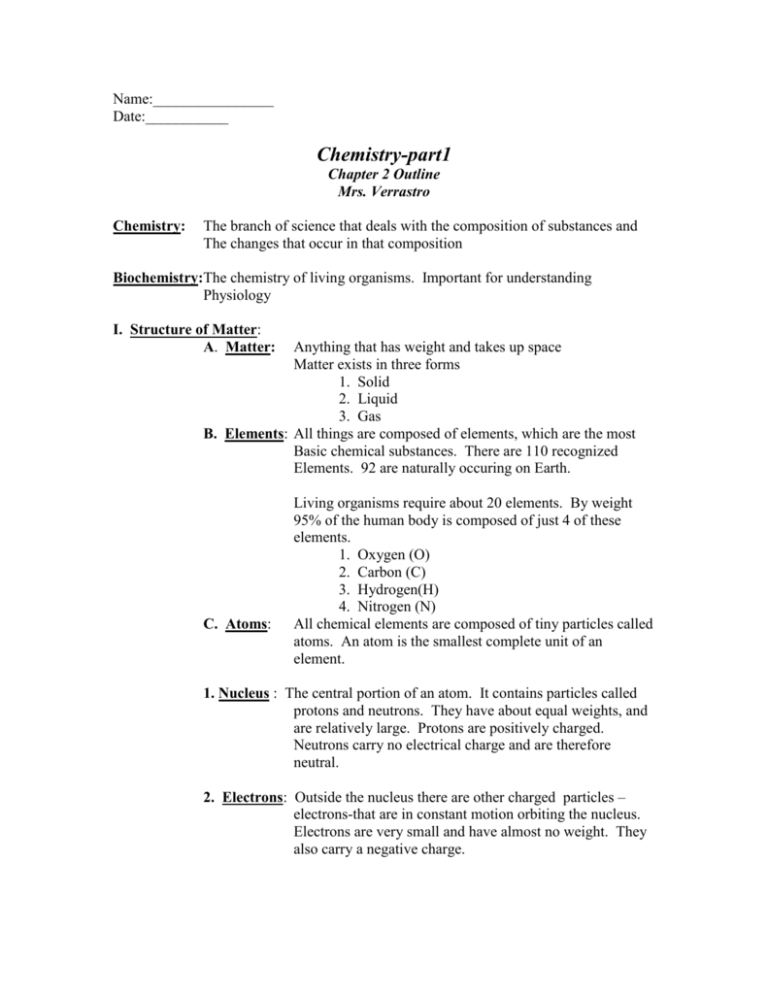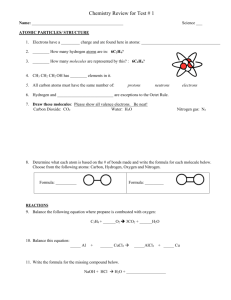Chemistry
advertisement

Name:________________ Date:___________ Chemistry-part1 Chapter 2 Outline Mrs. Verrastro Chemistry: The branch of science that deals with the composition of substances and The changes that occur in that composition Biochemistry:The chemistry of living organisms. Important for understanding Physiology I. Structure of Matter: A. Matter: Anything that has weight and takes up space Matter exists in three forms 1. Solid 2. Liquid 3. Gas B. Elements: All things are composed of elements, which are the most Basic chemical substances. There are 110 recognized Elements. 92 are naturally occuring on Earth. C. Atoms: Living organisms require about 20 elements. By weight 95% of the human body is composed of just 4 of these elements. 1. Oxygen (O) 2. Carbon (C) 3. Hydrogen(H) 4. Nitrogen (N) All chemical elements are composed of tiny particles called atoms. An atom is the smallest complete unit of an element. 1. Nucleus : The central portion of an atom. It contains particles called protons and neutrons. They have about equal weights, and are relatively large. Protons are positively charged. Neutrons carry no electrical charge and are therefore neutral. 2. Electrons: Outside the nucleus there are other charged particles – electrons-that are in constant motion orbiting the nucleus. Electrons are very small and have almost no weight. They also carry a negative charge. 3. Atomic Number: The number of protons in an atom. The number of protons equals the number of electrons. The atomic number also tells you how many number of electrons are in an atom. 4. Atomic Weight: The weight of an atom is determined from the weight of the protons and neutrons inside the nucleus. 5. Isotopes: Atoms that have the same atomic number but different atomic weights. (Ex. Carbon-6 and carbon-14) II. Molecules and Compounds: When two or more atoms bind together they form a molecule. If the atoms are the same type, they form a molecule of that element (O2 = a molecule of Oxygen). If atoms of different types combine, they form a molecule of a compound. A molecule is described by a molecular formula. It includes the letter symbol for the elements and the numbers of atoms of each present. Ex. H2O=water CO2=Carbon dioxide CO=Carbon monoxide C6H12O6=glucose III. Chemical Activity-interactions of atoms: How atoms interact is determined by how many electrons they contain. A. Chemical Bonding: 1. Atoms joining: Atoms can combine with other atoms by gaining, losing, or sharing electrons. An atom’s electrons are arranged around the nucleus in 1 or more shells (Like the rings of Saturn). Each shell has a certain capacity. 1st Shell- Can hold only 2 electrons 2nd Shell- Can hold 8 electrons 3rd Shell-holds more, and fourth still more. The first shell fills first, then the remaining electrons begin to fill the second shell. If it gets filled, the remaining electrons start to fill the third shell, etc. ( draw pictures here) 2.Stable/Inert Atoms: If the outer shell is completely filled, such as with helium, the atom is stable. It is chemically inactive=inert. It will not react with other atoms. If the outer shell if not filled, the atom is unstable and wants to become stable. It can easily gain, lose, or share electrons to become stable. That’s how atoms interact. 3. Ionic Bonding: Atoms gain or lose electrons to become stable. Once the electrons move, the atoms are no longer electrically neutral. An atom that gains an electron now has an extra negative charge, an antom that loses an electron has one less negative charge, making it positive. Ions- Atoms that have an electrical charge from gaining or losing electrons. Anion- a negatively charged ion Cation-a positively charged ion B. Covalent Bonding: Atoms can also bond by sharing electrons. Hydrogen has only 1 electron in its outer shell. It needs another to be stable. So two hydrogen atoms can share their electrons. (co-as in cooperating, or together) (Draw picture here) C. Hydrogen Bonds: A hydrogen bond is a weak bond formed between hydrogen atoms and another atom. Examples include liquid water and DNA chains. These bonds are easily broken and put back together. IV. The Organic Compounds Organic compounds contain carbon, hydrogen, and usually oxygen as well. Covalent bonds are most common. A. Carbohydrates Carbohydrates are sugars and starches. They are important energy sources for metabolic operations. They Contain Carbon, Hydrogen, Oxygen -1:2:1 ratio. A simple sugar, or monosaccharide, has from three to seven carbon atoms. Glucose is the most important monosaccharide. Disaccharides and polysaccharides form by dehydration synthesis. They can be broken apart through hydrolysis. Glycogen is the most important polysaccharide in our bodies; it is a storage form of glucose. B. Lipids Lipids are fats, oils, and waxes. Contain Carbon, Hydrogen, and Oxygen But with a lot less oxygen than carbohydrates Fatty acids are an example of lipids and are important energy sources. Fatty acids can be linked to a glycerol molecule by dehydration synthesis to form diglycerides and triglycerides. Triglycerides are an important storage form for lipids. Prostaglandins and some steroids function as hormones. Cholesterol is a precursor of steroid hormones, and is an important component of cell membranes. Cholesterol, phospholipids, and glycolipids are the structural lipids of the body. C. Proteins Proteins have two functional groups- Amine group (- NH2) and a Carboxylic group (- COOH) with an R group (radical-which determines what amino acid to attach) Structural proteins in the human body contain twenty different amino acids in significant quantities,but there are over 100,000 different proteins. Contains Hydrogen, Oxygen, Carbon, Nitrogen, sometimes sulfur Proteins are important as enzymes, structural components, hormones, regulators of metabolic activity, and buffers.They also function in movement, transportation of dissolved materials, and defense against disease and physical stresses. Enzymes are proteins that lower the activation energy requirements for chemical reactions. Enzyme names usually end with "-ase." Hydrolases, such as carbohydrases,are important enzymes responsible for breaking down compounds. D. Nucleic Acids Nucleic acids store and process genetic information concerning the structure of proteins. There are two types of nucleic acids, ribonucleic acid (RNA) and deoxyribonucleic acid (DNA). Nucleic acids are chains of nucleotides. Each nucleotide contains a phosphate group, a sugar, and a nitrogen base. In RNA, the sugar is ribose, and the nitrogen base may be adenine, guanine, cytosine, or uracil. In DNA, the sugar is deoxyribose, and the nitrogen bases are the same except for the substitution of thymine for uracil. Name:______________ Date:______________ Period:________ Matching Mrs. Verrastro 1. _______ Fatty acids a. Carbohydrate 2. _______Polysaccharide b. Lipid 3. _______ C,H,O in a 1:2:1 ratio c. Protein 4.________C,H,O,N,P d. Nucleic Acid 5.________C,H,O,N 6.________Glucose 7.________Prostaglandins 8.________Steroids 9.________ NH2 and COOH 10.________ DNA and RNA 11.________C,H, and a small amount of O 12.________Radical Group 13.________ Structural component of muscle 14.________ Insulates the body 15.________Stores and process information 16.________Primary energy sources for our bodies






